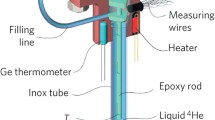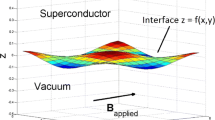Abstract
Measurements of the Kapitza resistance have been made on single Si(001) crystals at T > 1.5 K. The surface morphology of the samples was characterised by Atomic Force Microscopy (AFM). The results, interpreted using the Adamenko and Fuks (AF) model, demonstrate that nanometre-scale roughness produces diffuse and/or resonant phonon scattering. This explains the discrepancy between the measured Kapitza resistance and the Khalatnikov values.
Similar content being viewed by others
REFERENCES
I. N. Adamenko and I. M. Fuks, Sov. Phys. J. E. T. P. 32, 1123 (1971).
I. M. Khalatnikov, Introduction to the Theory of Superfluidity, Benjamin, New York, (1965), Chap. 23.
T. Nakayama, in Progress in Low Temperature Physics, F. Brewer (ed.) (1989), Vol. XII, pp. 115-194, Chap. 3.
N. S. Shiren, Phys. Rev. Lett. 47, 1466 (1981).
T. Klitsner and R. O. Pohl, Phys. Rev. B 36, 6551 (1987).
H. Kinder, A. Ninno, D. Goodstein, G. Paterno, and F. Scaramuzzi, Phys. Rev. Lett. 55, 2441 (1985).
J. Weber, W. Sandmann, W. Dietsche, and H. Kinder, Phys. Rev. Lett. 40, 1469 (1978).
J. M. Elson and J. M. Bennett, J. Opt. Soc. Am. 69, 31 (1979).
The heat flux is given by \(\dot Q = \frac{\hbar }{{(2\pi c_l )^2 }}\int {_0^\infty \;n(k,\;\omega )\;\omega ^3 \;d\omega } \;\int {_0^1 \;\tau (k,\vartheta )\;\cos \vartheta d(\cos \vartheta )} \) as in Ref. 2.
For \(\Theta \) ⩽ 0.3, f(\(\Theta \)) increases as ≈ 169\(\Theta \) 2. For \(\Theta \) > 0.3, f(\(\Theta \)) decreases rapidly and in the limit \(\Theta \) ≫ 1, f(\(\Theta \)) ≈ 0.92+0.038/\(\Theta \) 2.
J. Amrit and M. X. François, J. Low Temp. Phys. 119, 27 (2000).
P. E. Hegeman, H. J. W. Zandvliet, G. A. M. Kip, and A. van Silfhout, Surface Science 311, L655-660 (1994).
A. L. Barabasi and A. E. Stanley, Fractal Concepts in Surface Growth, Cambridge University Press (1995), Chap. 3.
J. C. Russ, Fractal Surfaces, Plenum Press, New York (1994), Chap. 8.
R. C. Johnson and W. A. Little, Phys. Rev. 130, 596 (1963).
Author information
Authors and Affiliations
Rights and permissions
About this article
Cite this article
Amrit, J., François, M.X. Nanoscale Surface Roughness Contribution to the Kapitza Resistance Between Superfluid He and Silicon. Journal of Low Temperature Physics 128, 113–121 (2002). https://doi.org/10.1023/A:1016341826786
Issue Date:
DOI: https://doi.org/10.1023/A:1016341826786




